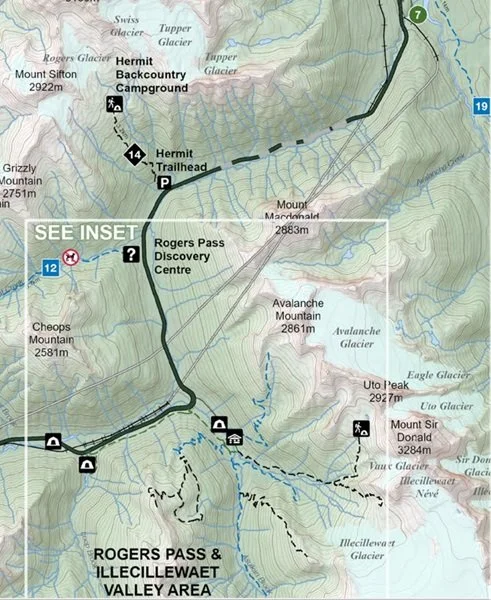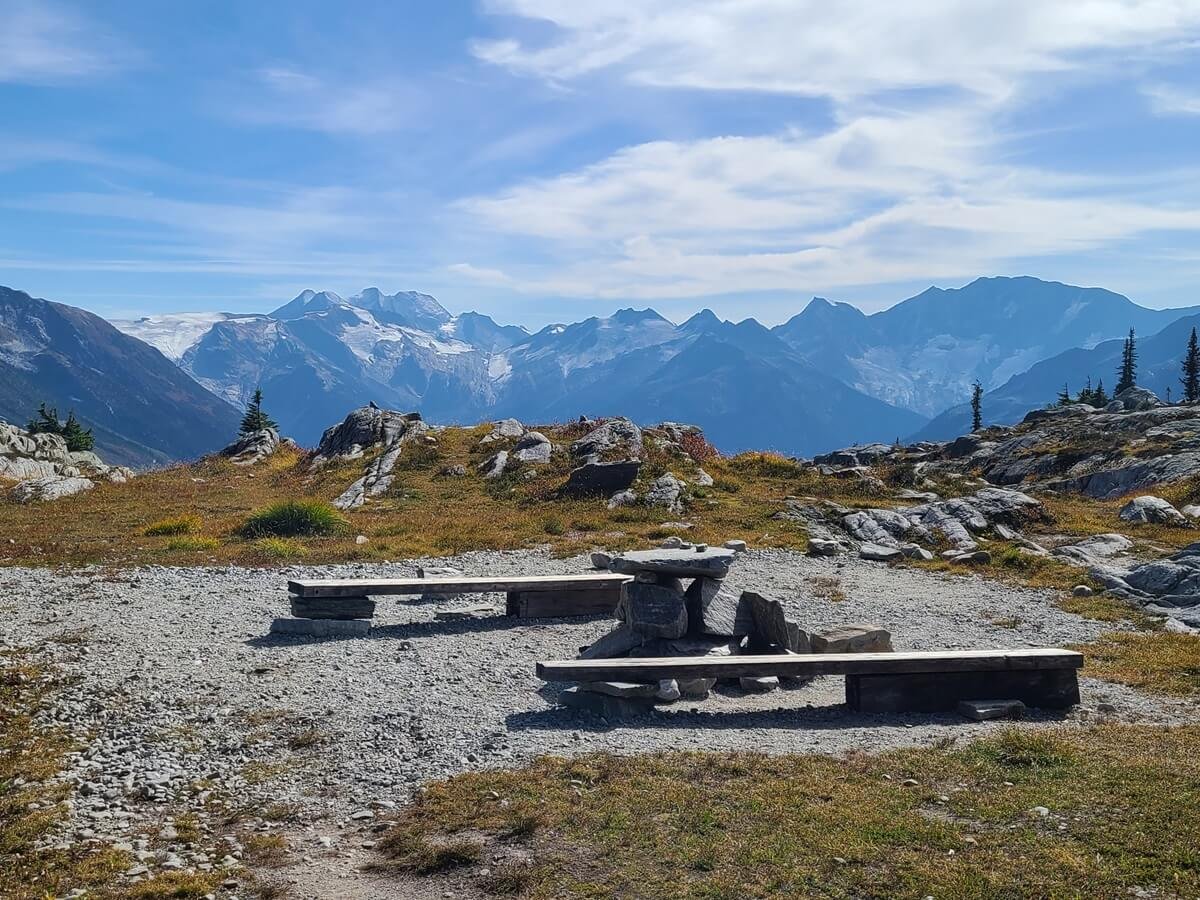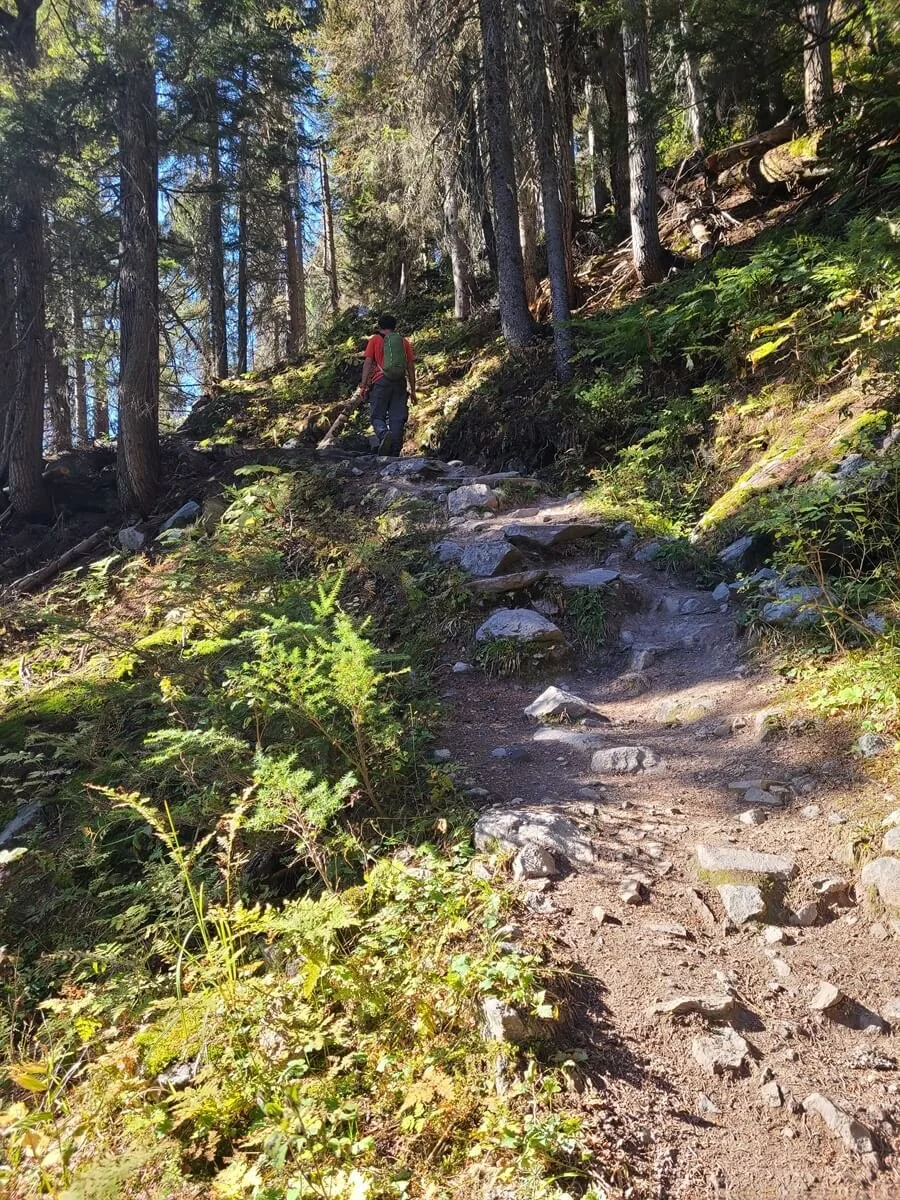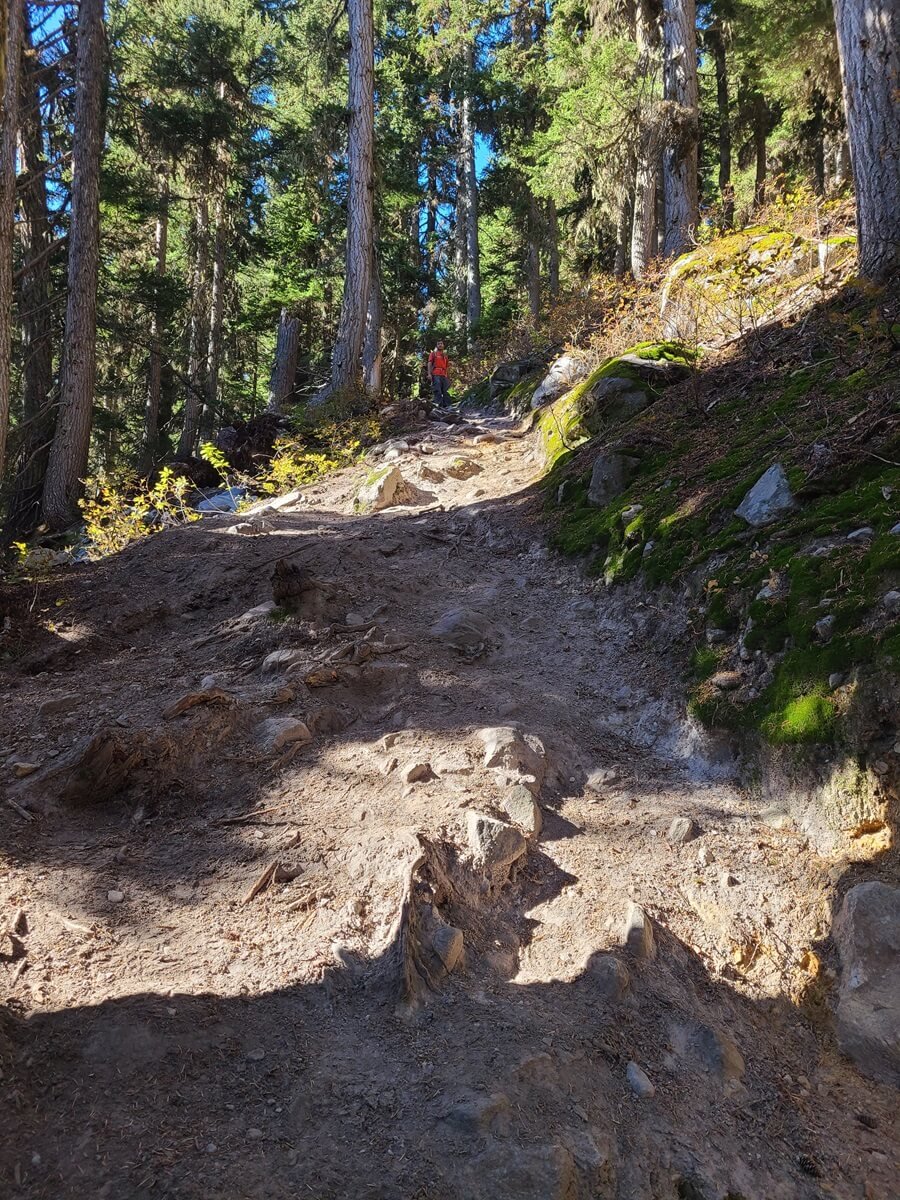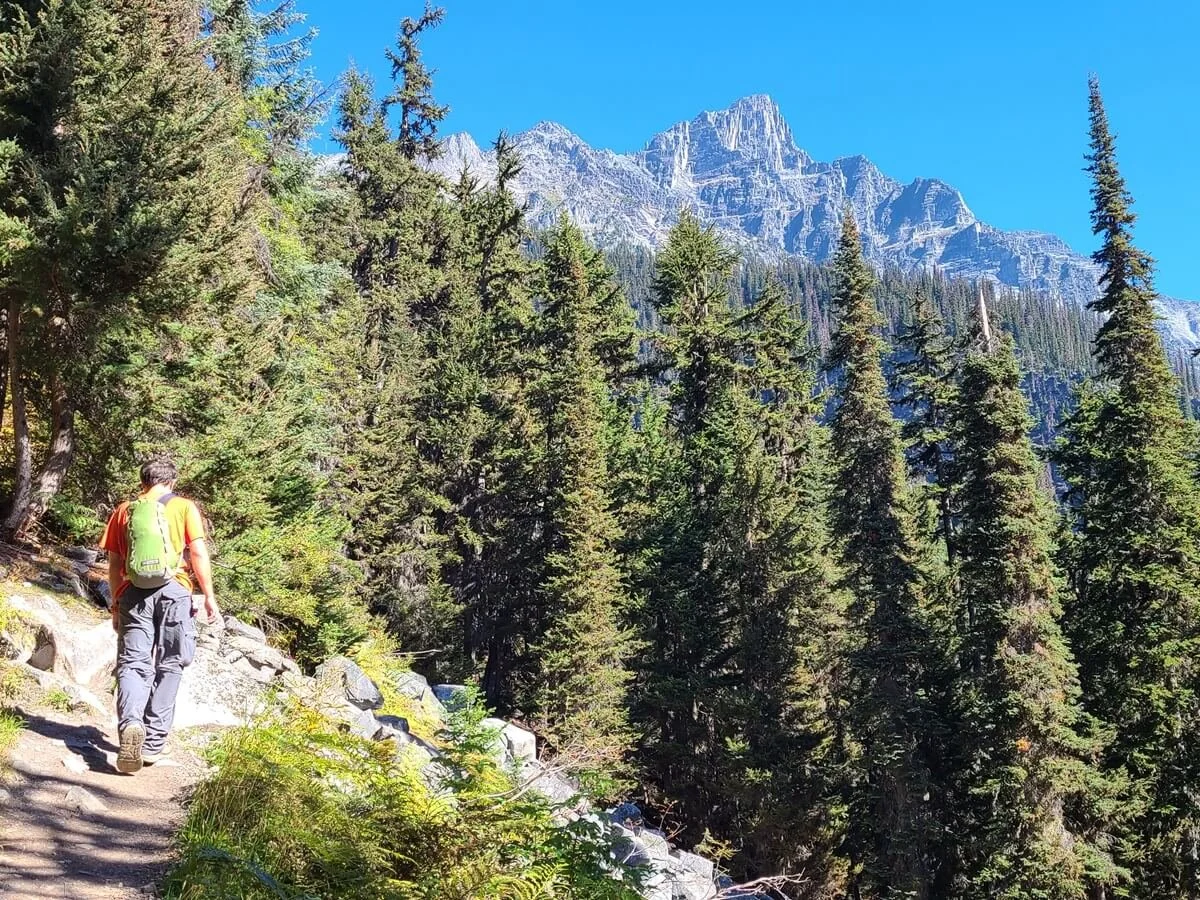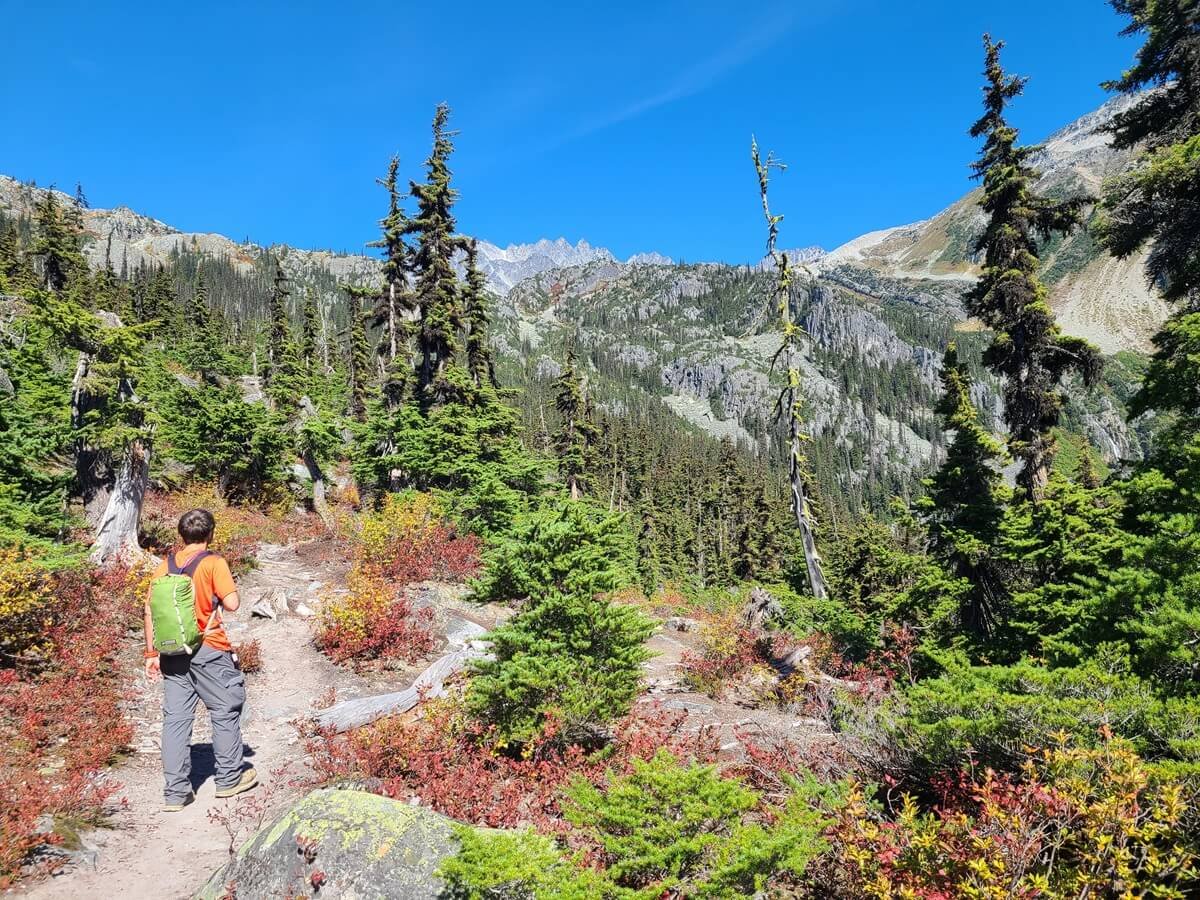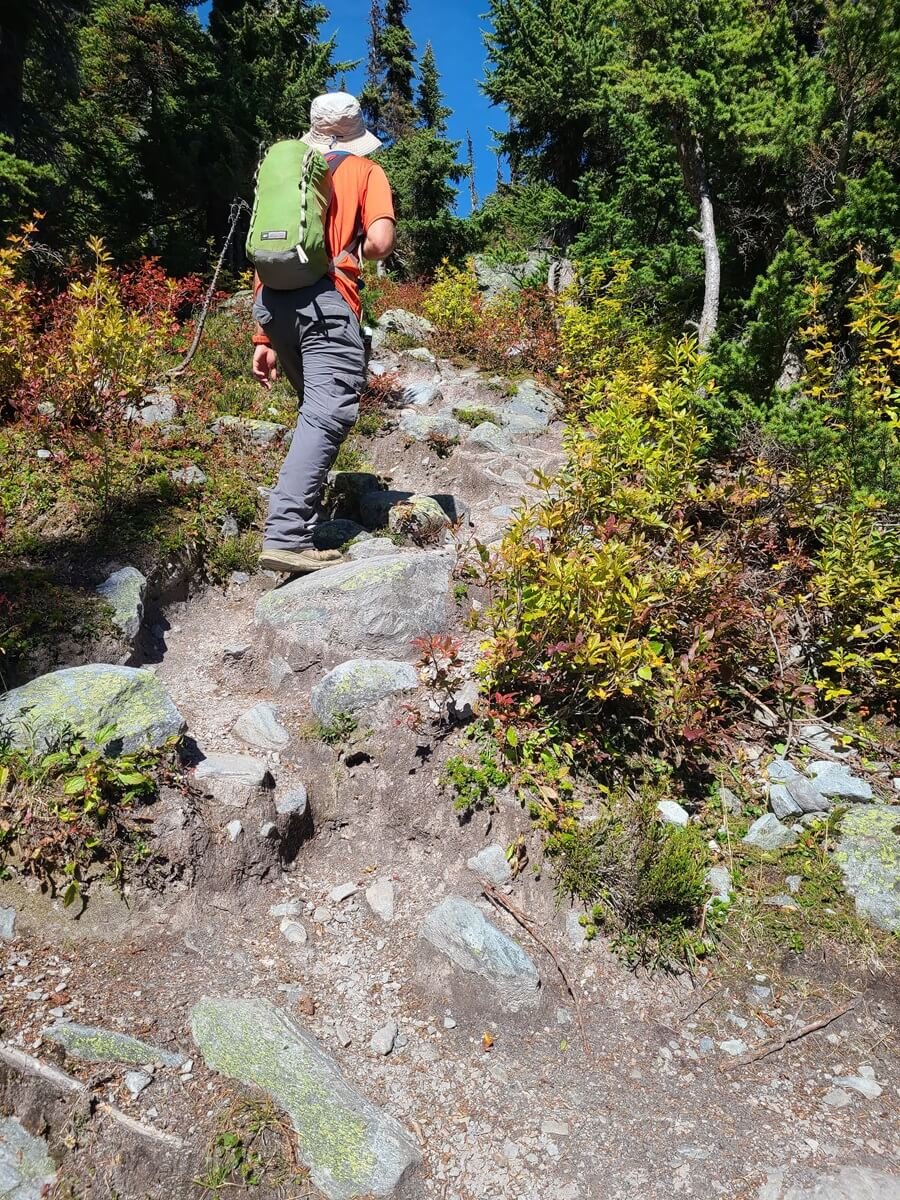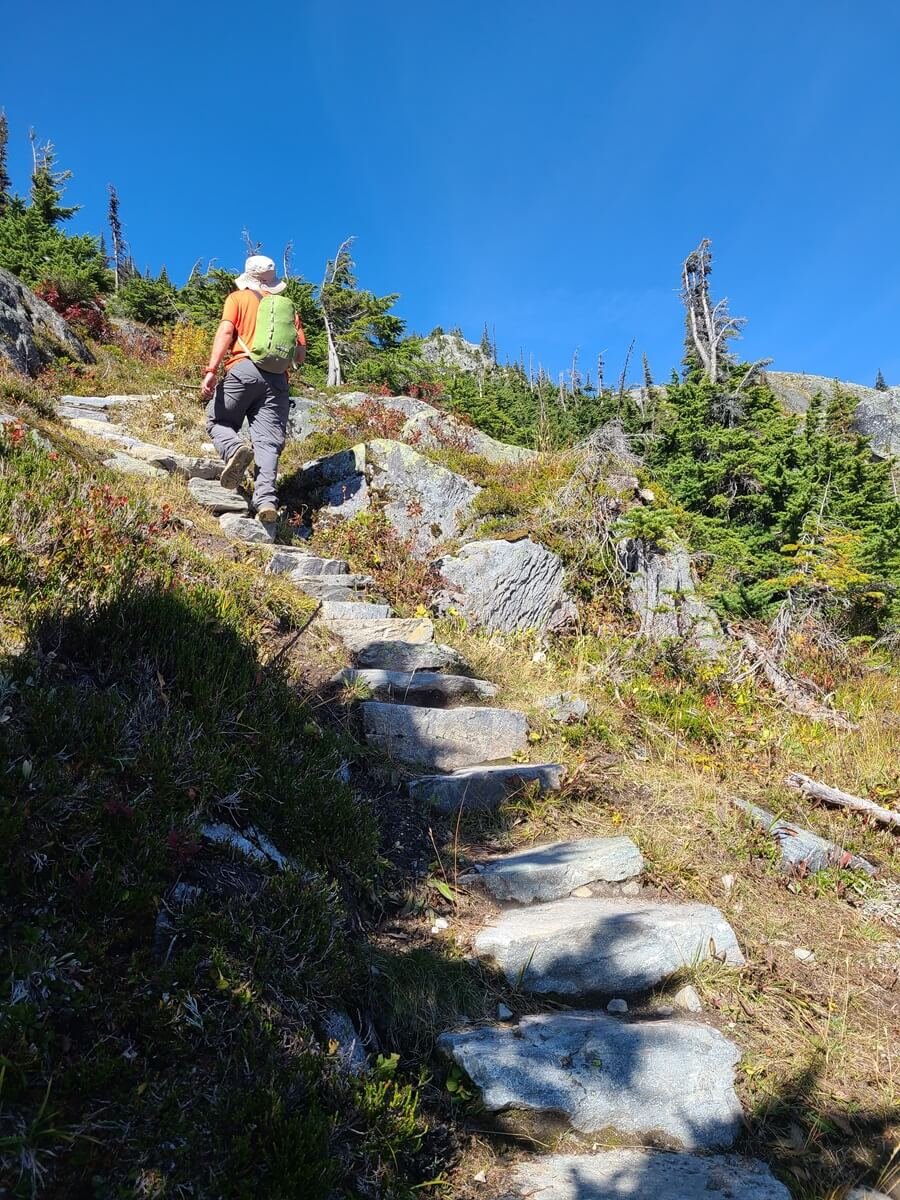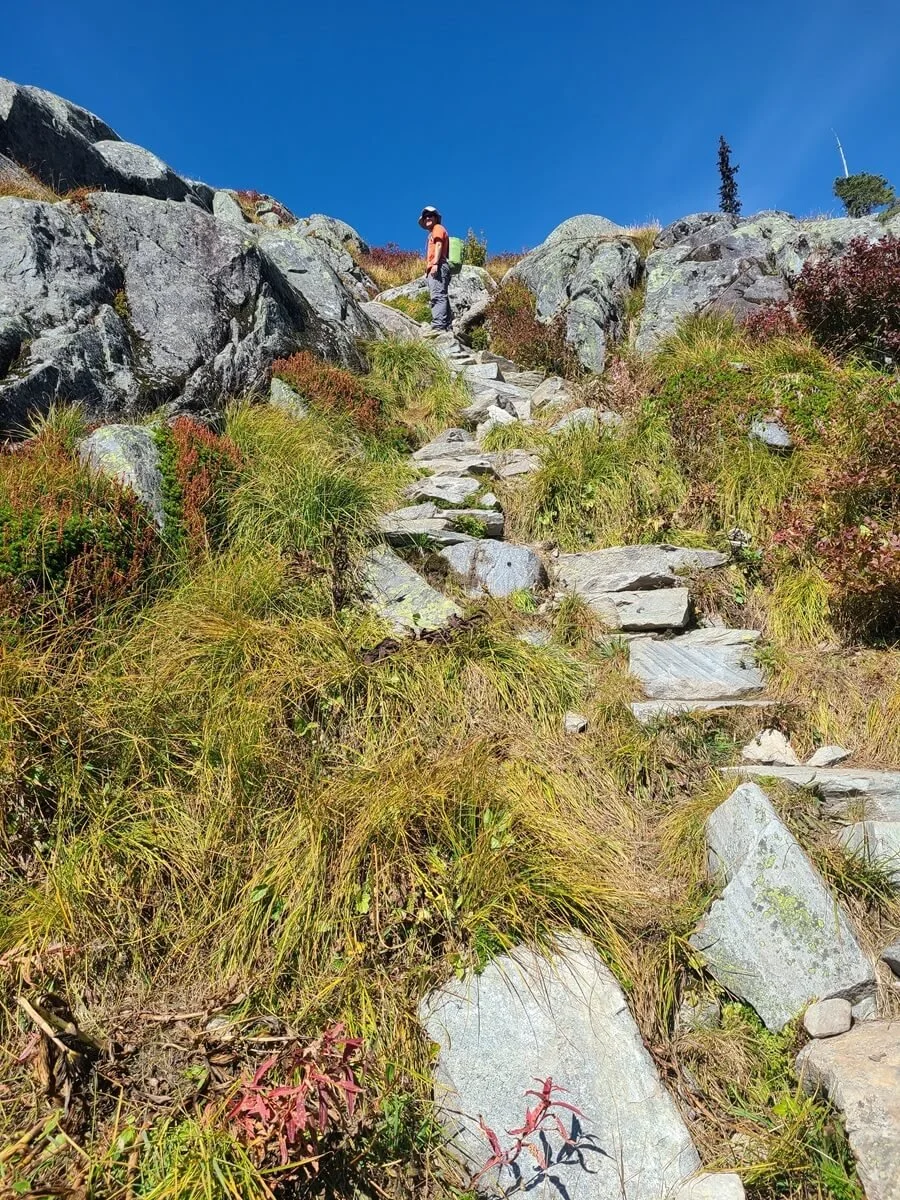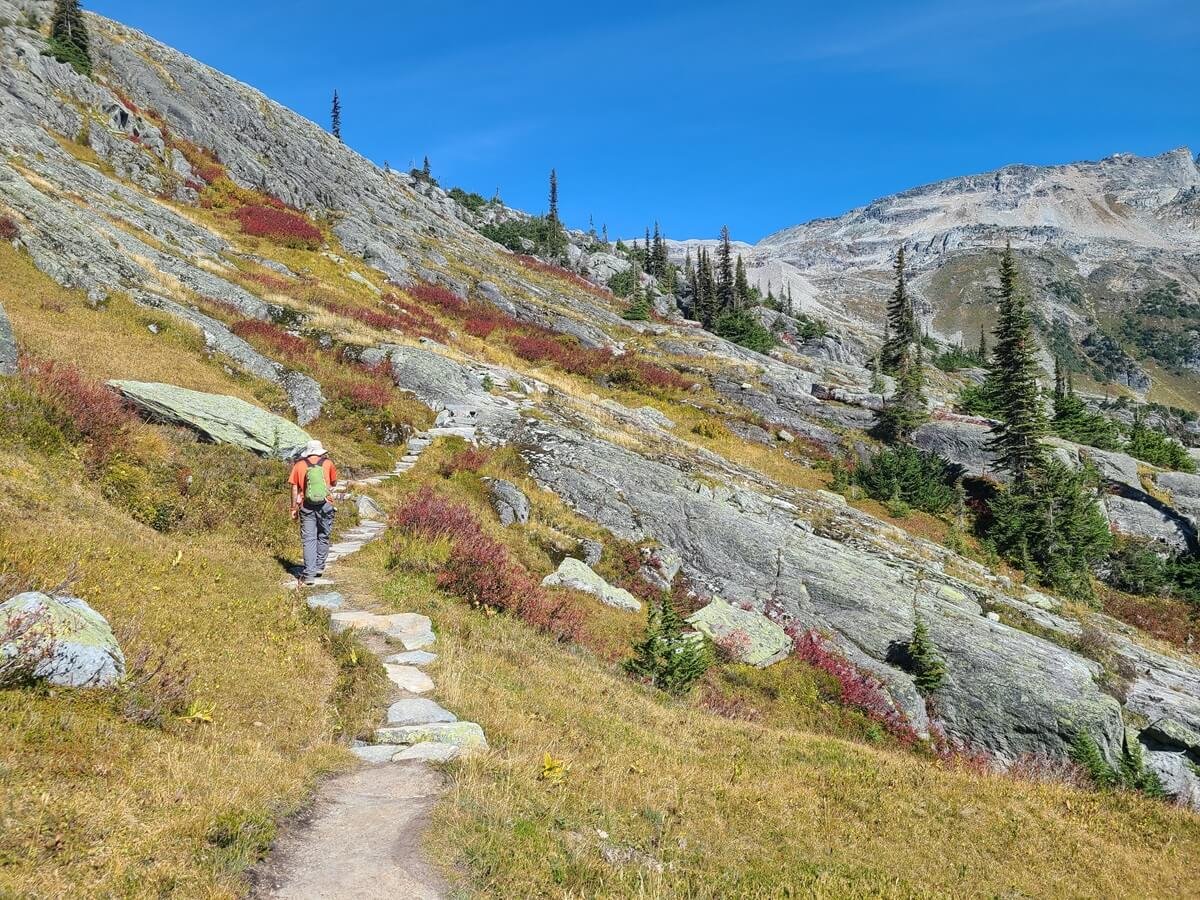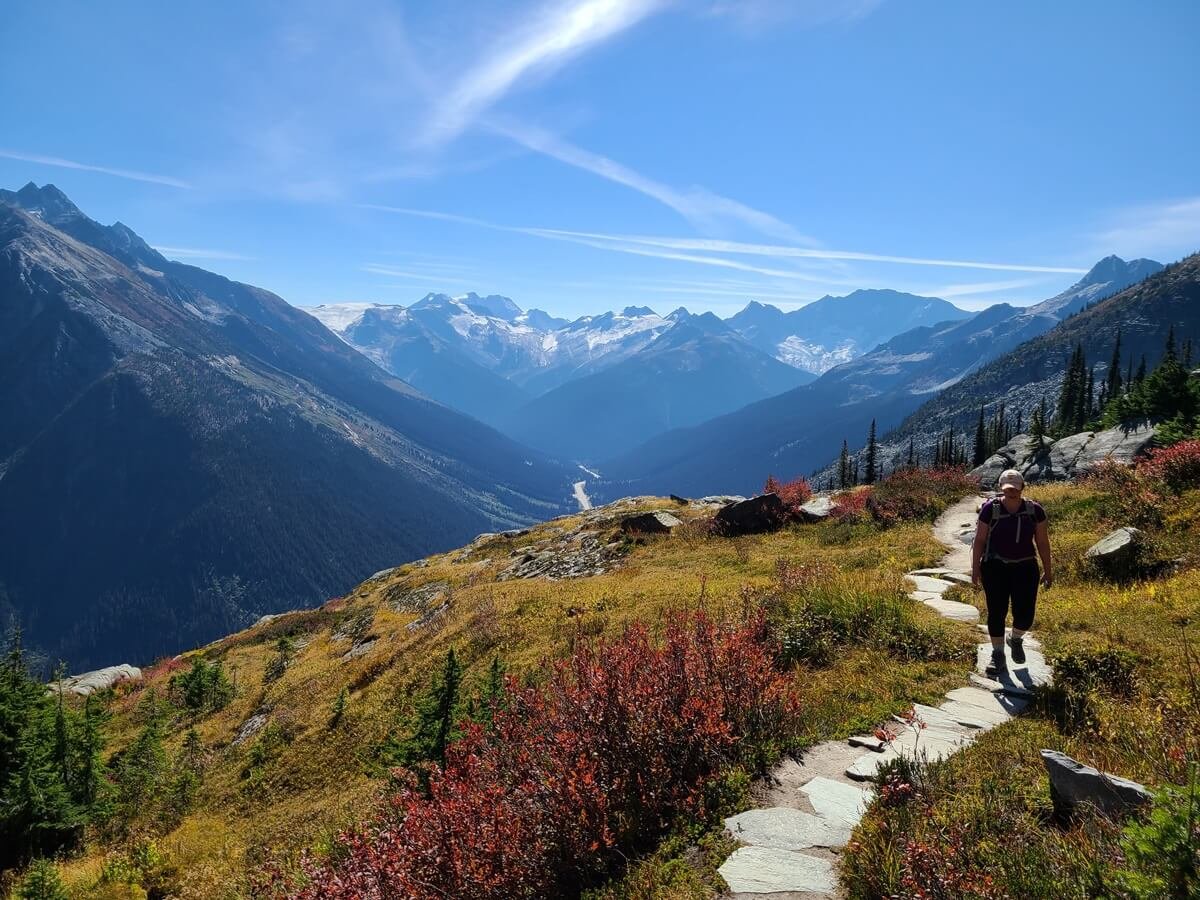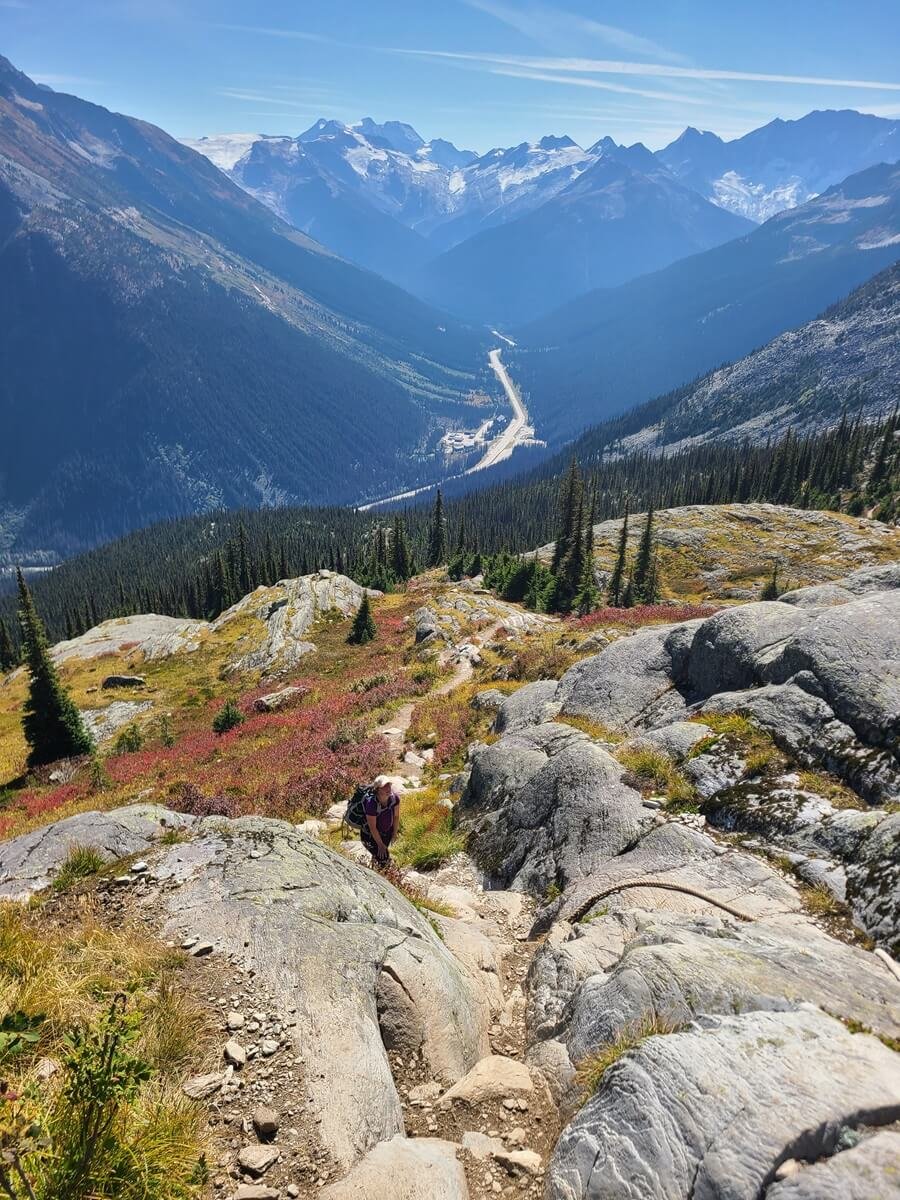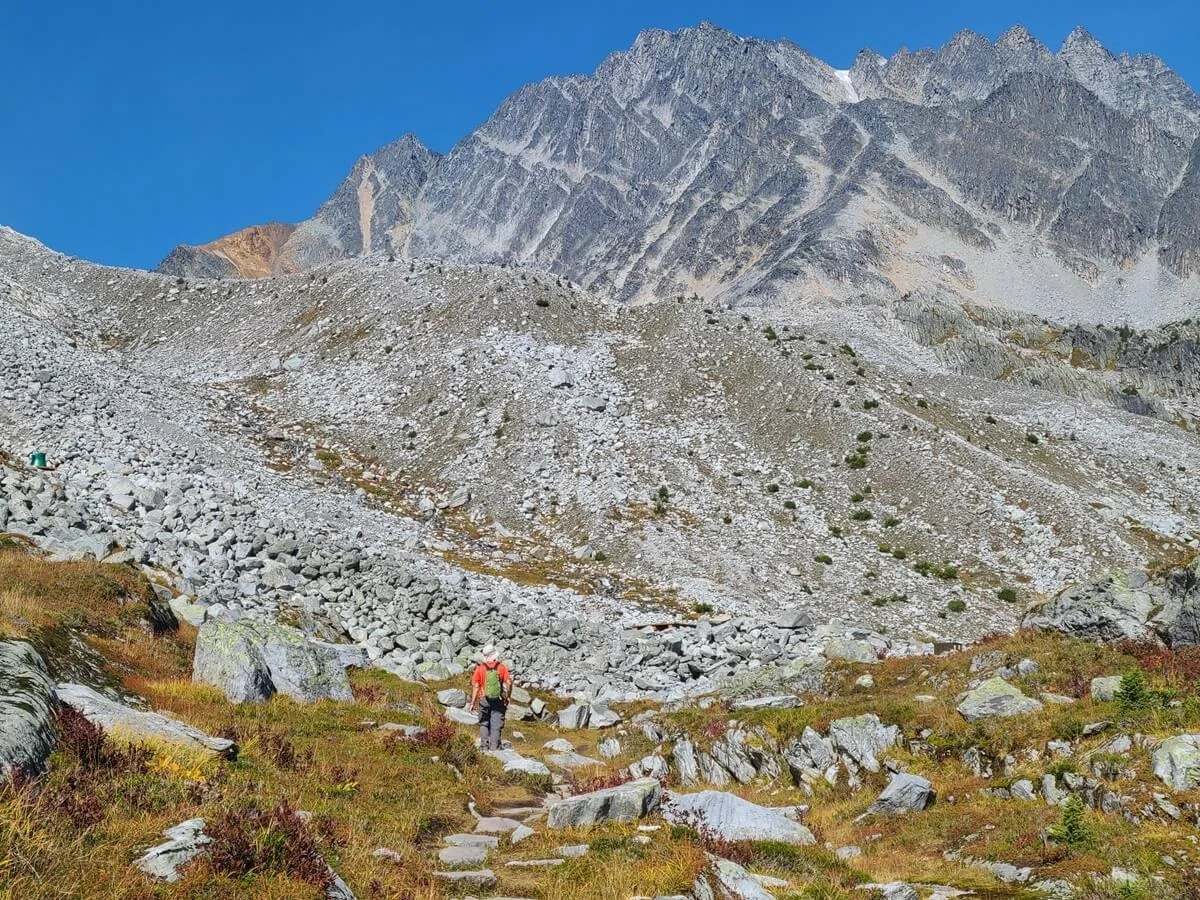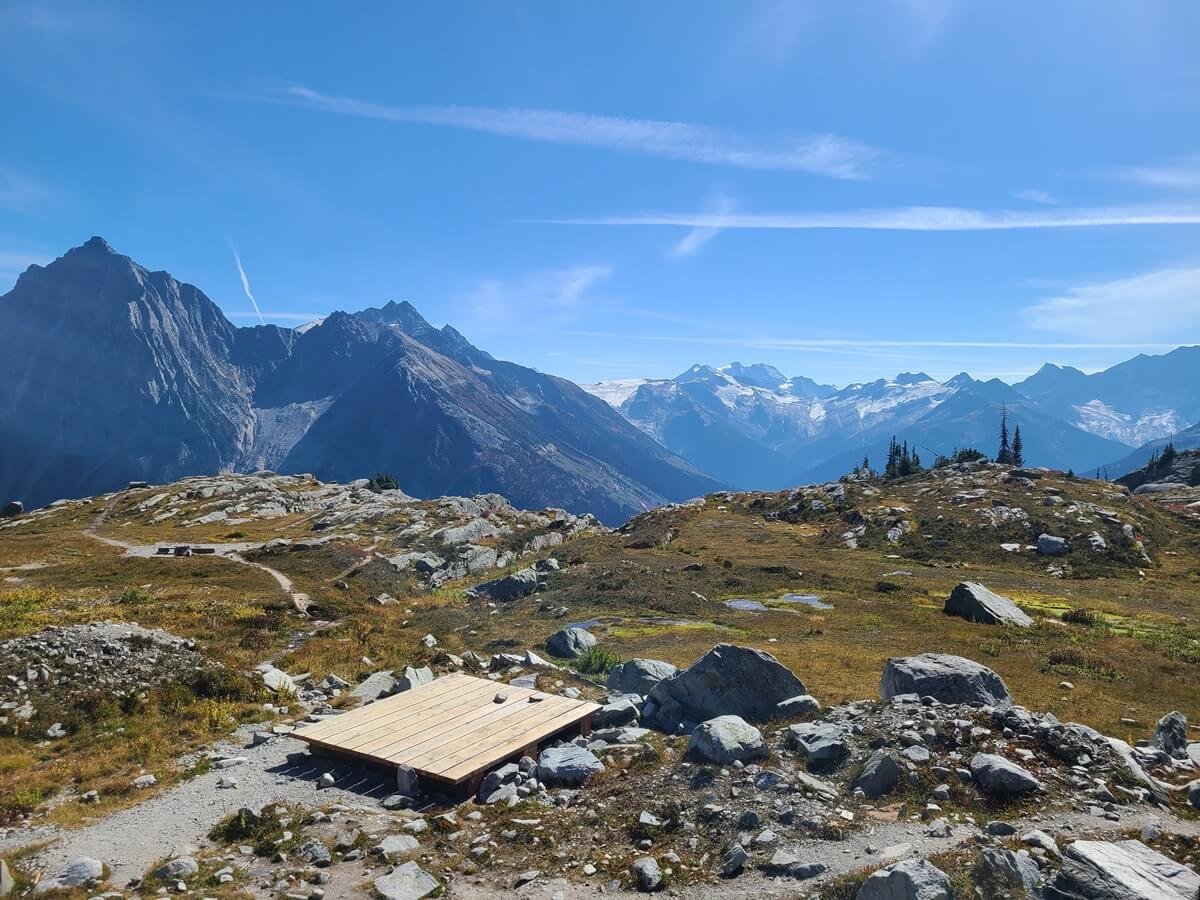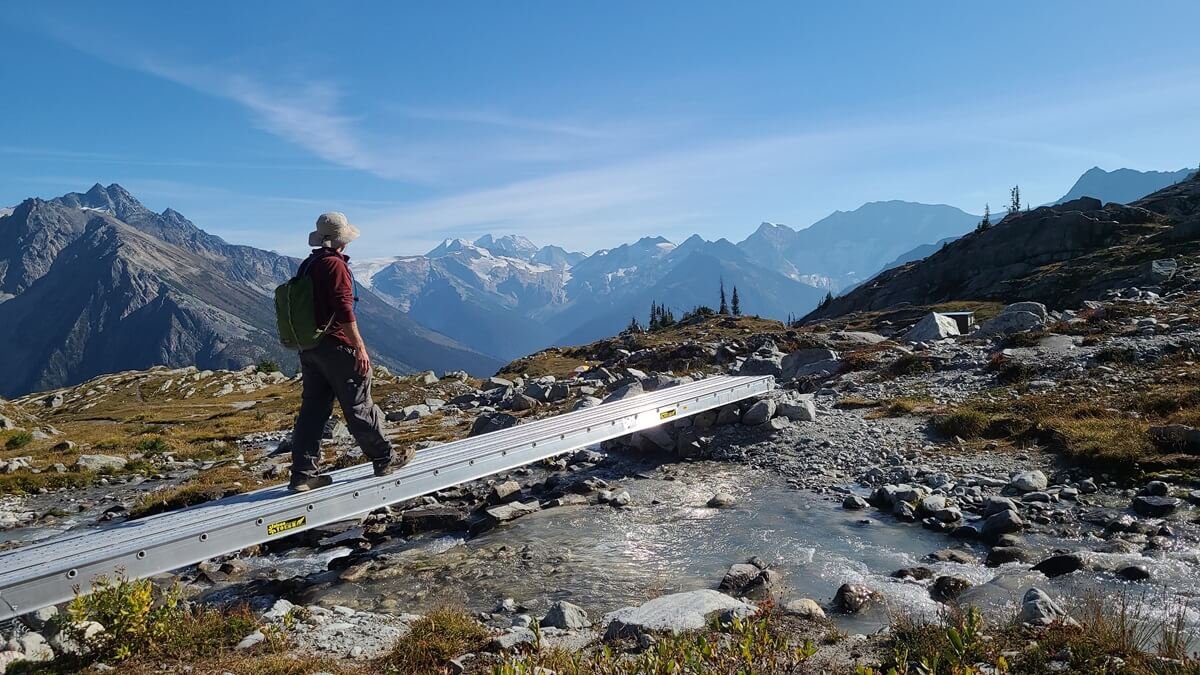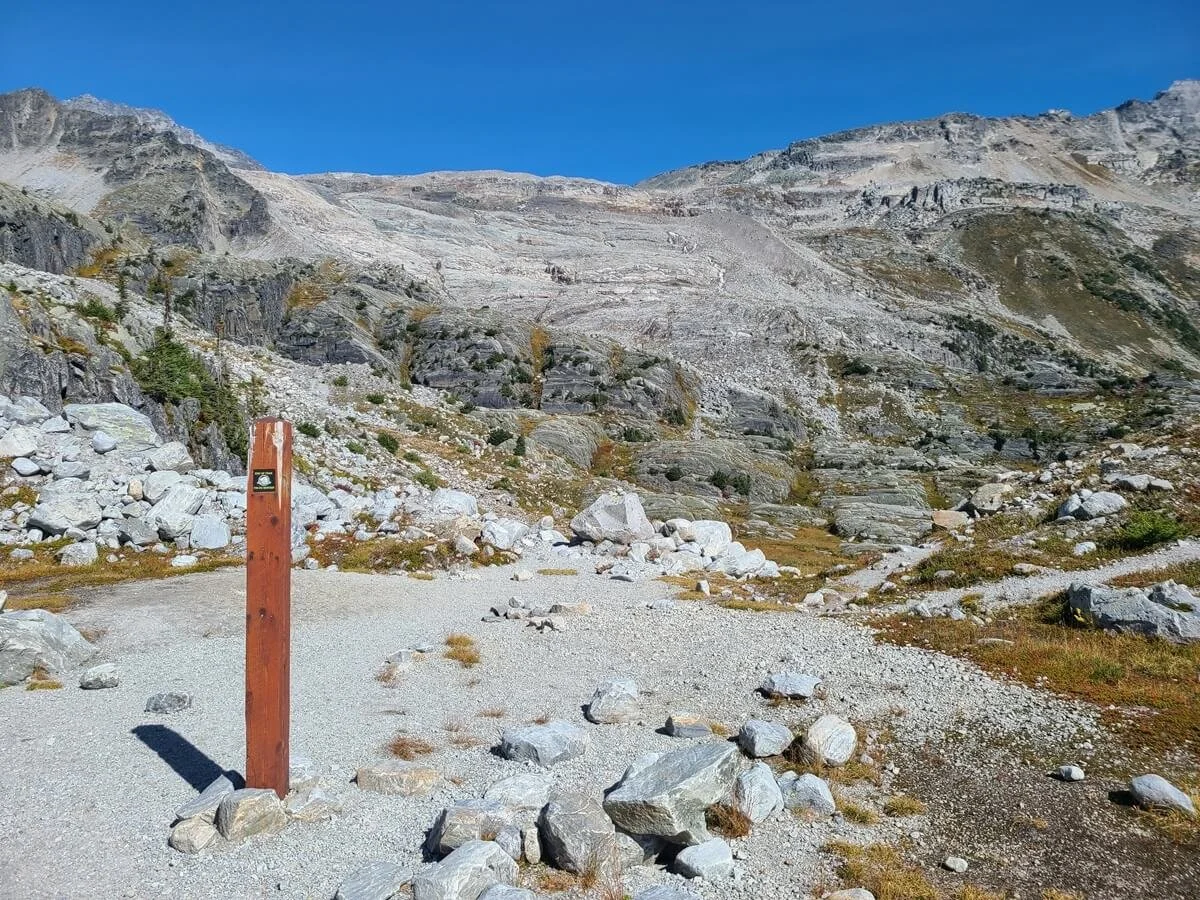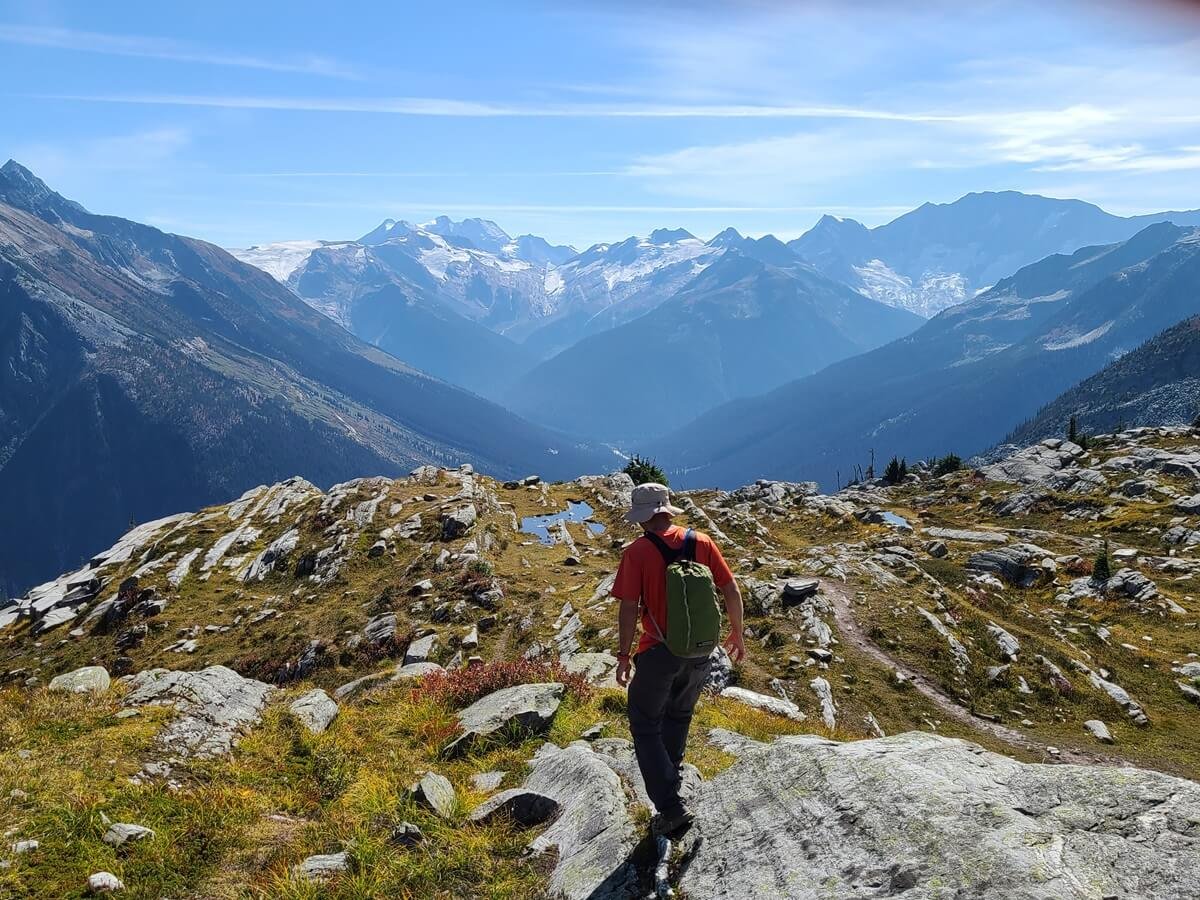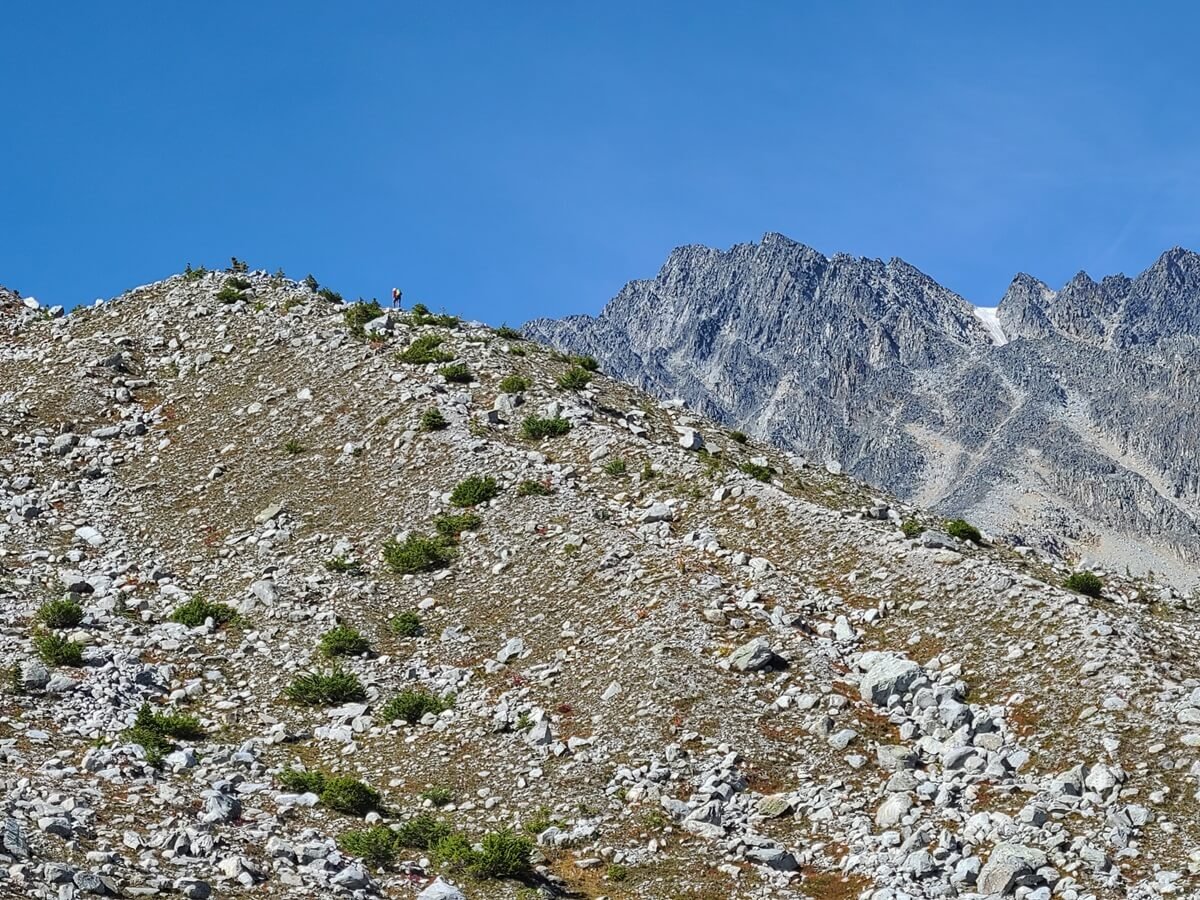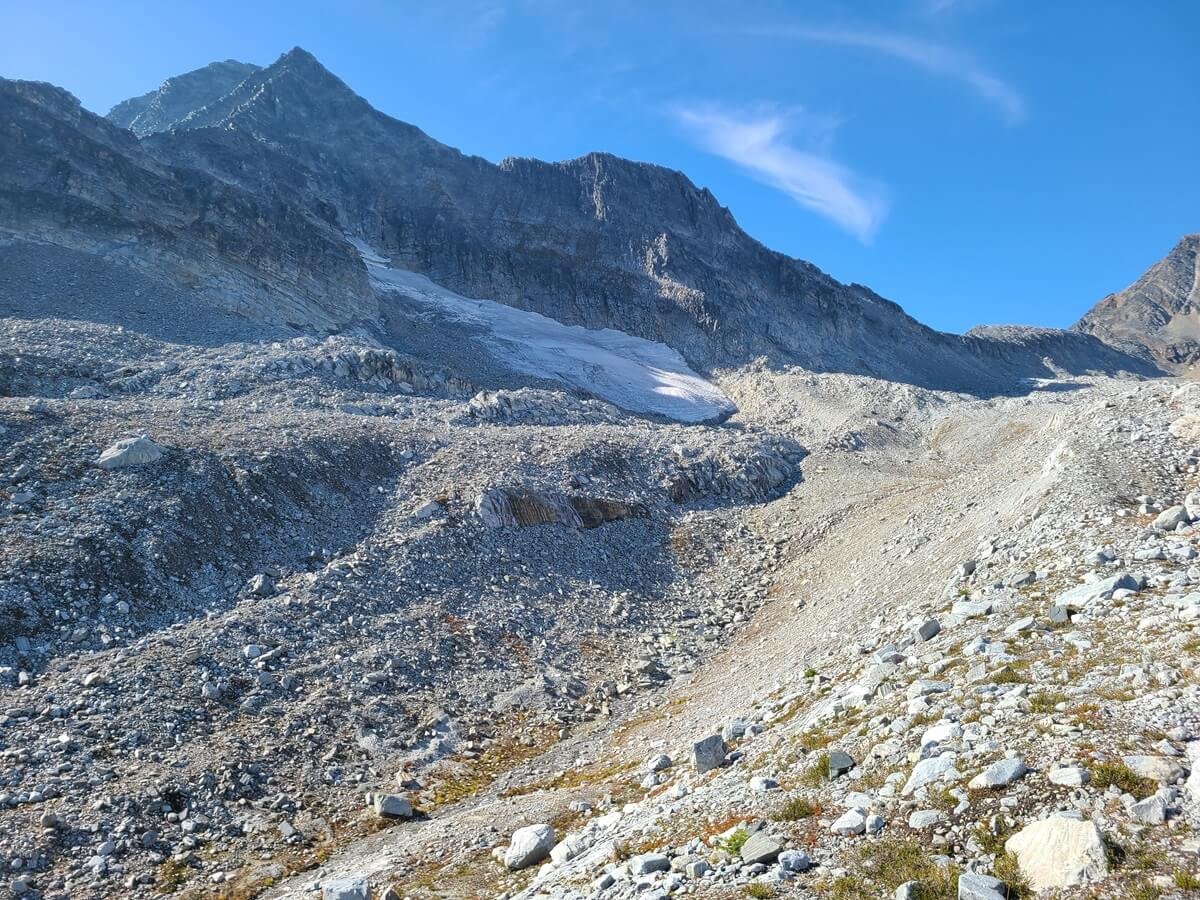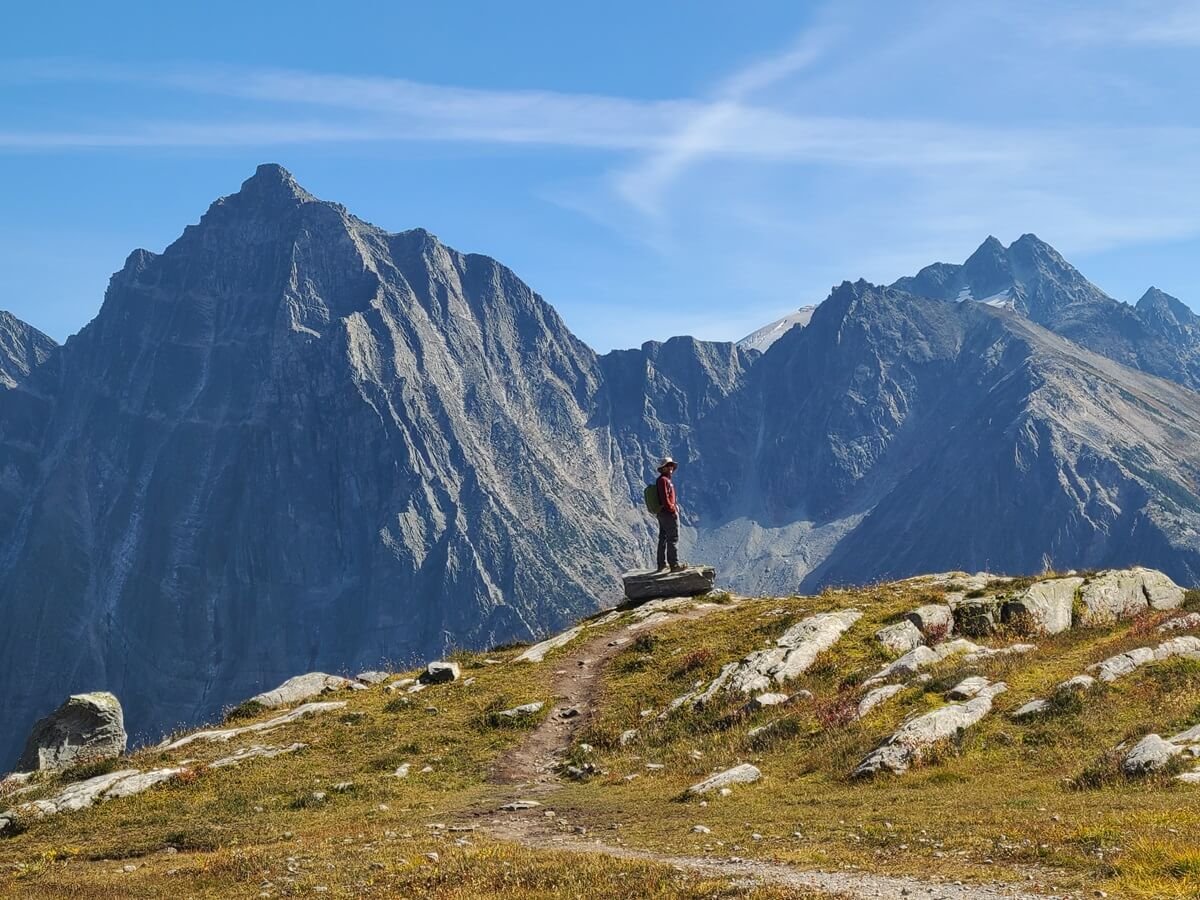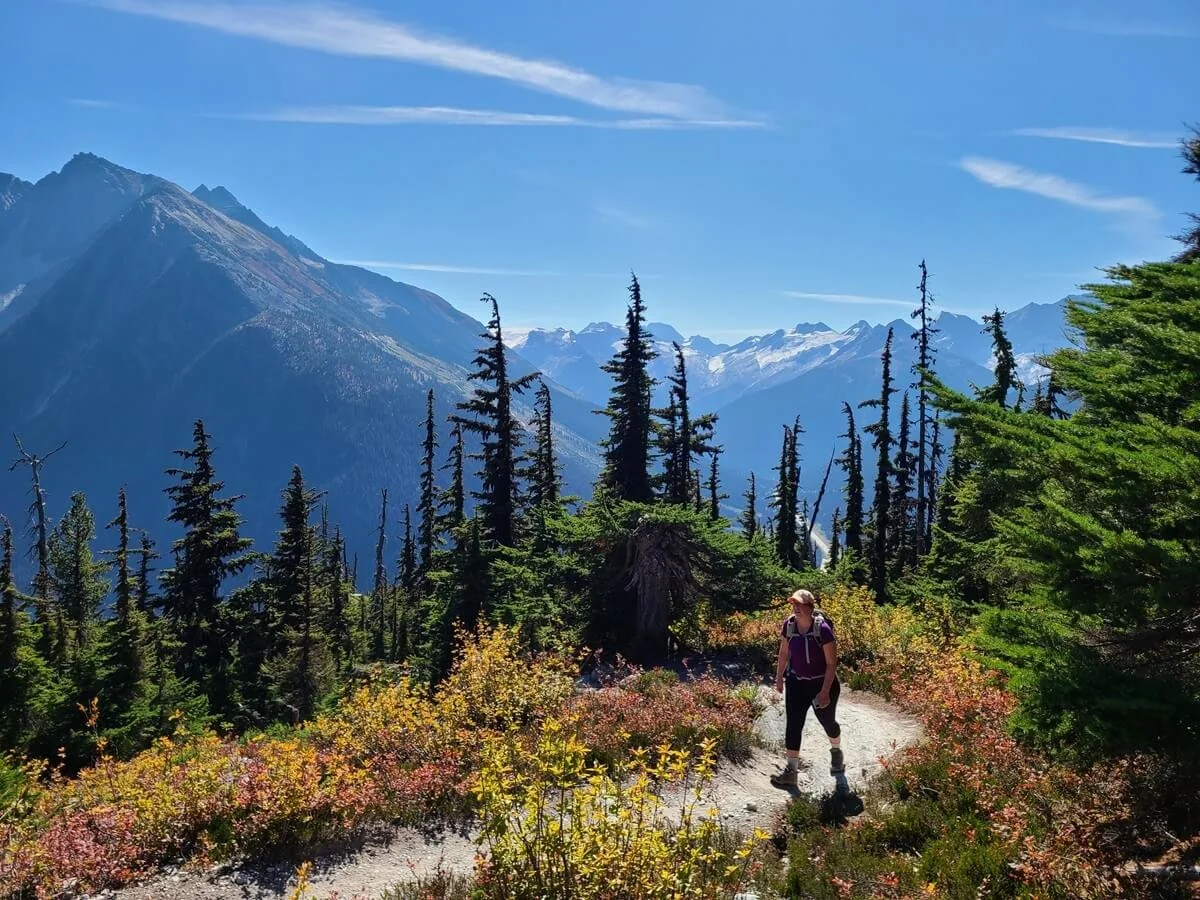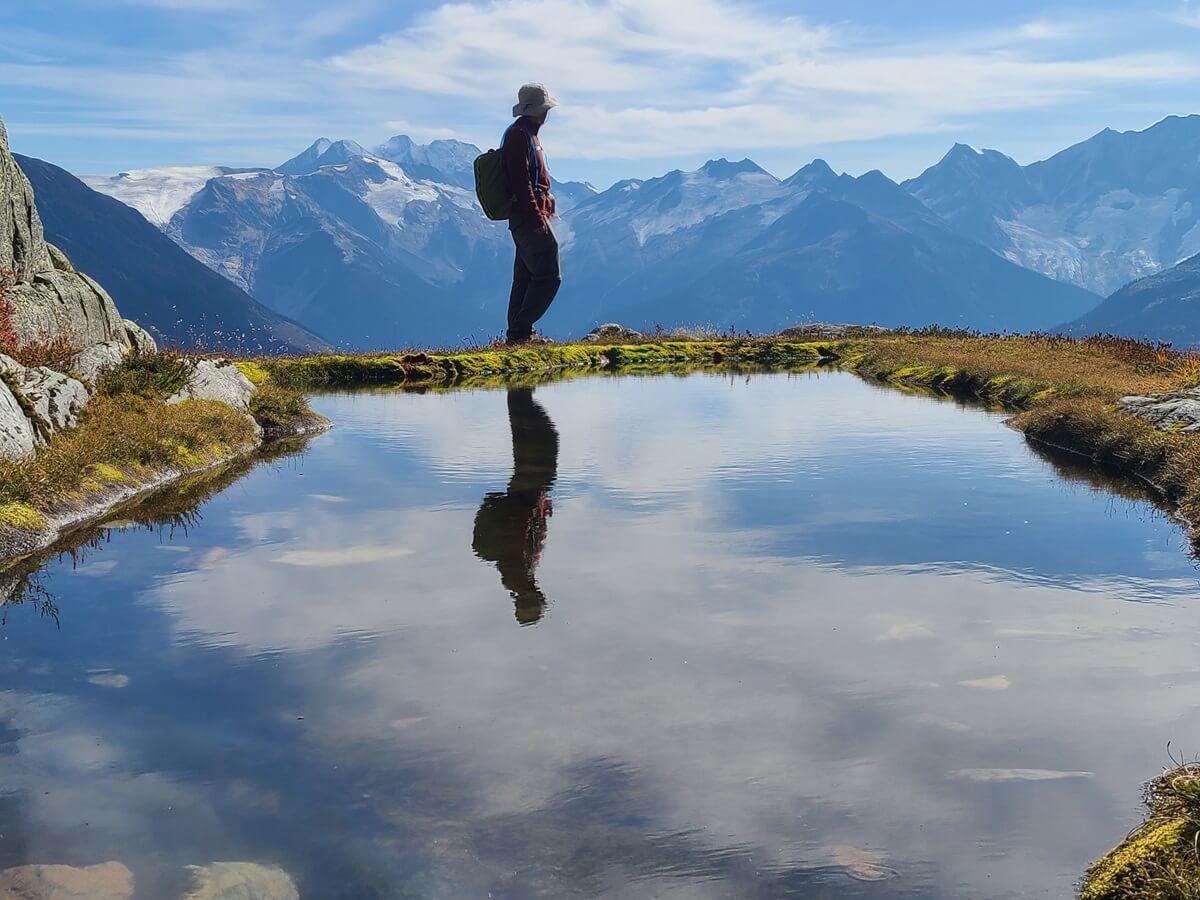How to Hike the Hermit Trail in Glacier National Park, British Columbia
The Hermit Trail in Glacier National Park is a steep and challenging hike in British Columbia that leads to a gorgeous alpine meadow and campground overlooking Rogers Pass and the surrounding mountains. In this guide, learn everything you need to know about how to day hike the Hermit Trail in Glacier National Park, and how to camp at Hermit Meadows if you want to spend the night!
While many people flock to the Canadian Rockies for the famous sights and trails of places like Banff National Park and Jasper National Park, just two hours away lies a quieter, but no less stunning, national park where you can get epic alpine views without the crowds of its more famous neighbors.
Sound good? Then on your visit to the Canadian Rockies, be sure to check out Glacier National Park of Canada.
Not to be confused with the famous park that shares its name in Montana, Glacier National Park of Canada lies just two hours west of Banff along the TransCanada Highway. While not technically part of the Canadian Rockies, Glacier National Park showcases the alpine scenery of the nearby Columbia Range, and is home to a handful of challenging hikes that lead to panoramic views of mountains, glaciers, and alpine meadows.
One of the best hikes in Glacier National Park of Canada is the Hermit Trail. The Hermit Trail ends at a beautiful alpine bowl called Hermit Meadows, with picturesque views over alpine tarns, jagged mountains, and distant glaciers. And what’s even better? There is a backcountry campground right in Hermit Meadows so that you can make the most of your time exploring the area and get an incredible sunset and sunrise from one of the most scenic and epic campgrounds we’ve ever seen.
But these views don’t come particularly easy. Glacier National Park is known for its incredibly steep hiking trails that climb straight up steep slopes to get to ridges and viewpoints, and the Hermit Trail is the steepest one of the bunch. But if you can survive the tough workout, the rewards at the top of the Hermit Trail are more than worth it.
In this guide, we’ll go over everything you need to know to hike the Hermit Trail in Glacier National Park, including how to get to the trailhead, how hard the Hermit Trail really is, what to expect on the trail, how to camp in Hermit Meadows, and so much more. So, let’s get to it!
In this Hermit Trail hiking guide:
How to Get to the Hermit Trail Trailhead
Glacier National Park of Canada lies 2 hours west of Banff National Park on the TransCanada Highway. The highway is the only road that traverses the park, and the highlight of this road is Rogers Pass. Here, views of jagged peaks and glaciers surround you simply from the seat of your car. You’ll also find here the Glacier National Park visitor center (called the Rogers Pass Discovery Center), frontcountry camping opportunities, and many of the best hikes in Glacier National Park of Canada, including the Hermit Trail (and also check out the Glacier Crest Trail on the other side of the pass for more amazing views!).
Driving through Rogers Pass in Glacier National Park of Canada on the way to the Hermit Trail
Nearest towns to Glacier National Park of Canada:
Golden: 1 hour (83 km) east of Rogers Pass
Revelstoke: 45 minutes (65 km) west of Rogers Pass
Other driving distances to Glacier National Park of Canada:
Lake Louise: 1 hour 50 minutes (160 km)
Banff: 2.5 hours (225 km)
Jasper: 4.5 hours (387 km)
Calgary: 3.5 hours (343 km)
Vancouver: 6.5 hours (630 km)
The trailhead for the Hermit Trail is about 2 km east of the Rogers Pass Discovery Center along the TransCanada Highway. The small lot is well-signed and pretty obvious so you can’t miss it.
The parking lot for the Hermit Trail in British Columbia
Glacier National Park of Canada map
This map shows the location of Glacier National Park in relation to other Canadian National Parks in the Canadian Rockies.
Hermit Trail map
This Glacier National Park map shows where the trailhead for the Hermit Trail is in relation to Rogers Pass.
The Hermit Trail is just a few kilometers away from the Rogers Pass Discovery Center and trails of the Illecillewaet Valley
How Long is the Hermit Trail in Glacier National Park?
While the Hermit Trail is short, it’s a steep and challenging climb. Here are our stats for hiking the Hermit Trail in Glacier National Park. These stats represent climbing from the parking lot to the official End of Trail sign in Hermit Meadows.
Length: 7 km (4.4 miles) roundtrip*
Elevation gain: 823 meters (2,700 ft)
Time: 4 hours- it took us 2.5 hours up and 1.5 hours down, but plan for time to explore the meadows…we spent about 3 hours at the top! Alternatively, you can make this an overnight trip by spending the night at the Hermit Meadows campground, which we talk more about below.
*A note on the length of the Hermit Trail: While there is a sign marking the official end of the Hermit Trail in Hermit Meadows, the meadows really just mark the start of the exploring you can do from there. Hermit Meadows is often used as a basecamp for mountaineering objectives in the nearby peaks, but less intense exploring can be done as well. In our trail description below, we’ll talk about a couple of ways you can explore further past the official end of trail.
Elevation profile:
Our elevation profile of the Hermit Trail. We continued tracking as we explored beyond Hermit Meadows, so we shaded in grey the portion of our hike that is not included in our stats above.
Here’s a satellite view of our Hermit Trail hike. You can tell how steeply it climbs! We’ve marked where the official end of trail is, but you can still see where we explored beyond the meadows.
How Hard is the Hermit Trail in Glacier National Park?
The Hermit Trail may be short, but don’t let that fool you! It’s short, but it’s steep as you can see from our stats above, gaining elevation at an average rate of about 230 meters per km (1200 feet per mile). And it’s a pretty consistent climb, so there’s not much of a break until you reach the top.
Fortunately, there’s nothing technical about the Hermit Trail. There is one part towards the top where there is a rope to help you climb over a particularly steep boulder along the trail, however we didn’t even find the rope necessary and just did a quick scramble along the side of it. Either way, it’s nothing difficult (check out our trail description below to see what this looks like!). So really, the Hermit Trail is just a good old-fashioned huff to the top. If you can handle several hours of steady steep uphill climbing, then you’re good.
The Hermit Trail is known for being the steepest trail in Glacier National Park!
Of course, the hike out is also steep, just in the down direction, so this could be hard on the knees for some people. Trekking poles could definitely help here.
For reference, the park itself gives the Hermit Trail a black diamond rating, which is reserved for its hardest trails.
A note on backpacking the Hermit Trail: If you plan on spending the night by camping in Hermit Meadows, then you’ll be hiking the Hermit Trail with the weight of a full pack, which will make the hike considerably harder, and probably a bit slower. As much as spending the night up in the meadows looks absolutely amazing, while I was hiking the trail I kept thinking about how I couldn’t imagine having a full pack while going up or down some of those particularly steep sections along the trail! As we were coming down from our day hike, we saw most of the backpackers for the night on their way up, and it looked like a struggle! But I’m completely confident that it’s worth it…getting more time to explore the meadows, enjoying the solitude after the day hikers have left, getting amazing sunrises and sunsets, and getting more opportunities to see wildlife!
Speaking of which….
How to Camp in Hermit Meadows in Glacier National Park
Spending the night at Hermit Meadows at the end of the Hermit Trail would be an amazing experience! The Hermit Meadows campground is easily one of the most picturesque and scenic campgrounds we have ever seen. There are 8 tent pads scattered throughout the meadows, and each one has an amazing view over the meadows and the jagged peaks and glaciers beyond.
How epic is this camping spot in Hermit Meadows?!
Each of the 8 campsites in Hermit Meadows has a wooden platform to set a tent on. The sites are scattered among the bottom of a rocky moraine and aren’t particularly private, but that’s the compromise you have to make to have amazing tent-side views.
There is one exception, though. If you want the absolute best campsite in Hermit Meadows, listen up!...
While the other campsites are all clustered together at the base of the moraine, campsite #8 stands alone. Walk the path through the campsite until you hit the small stream running across the meadows. On the other side of the stream is a small hill. You’ll see a spot where you can cross the stream and climb a steep little herd path up to the top of this hill to the best campsite in Hermit Meadows. It’s completely isolated from the others and has amazing views down over the meadows and scattered alpine tarns. We were kind of upset that we didn’t plan on camping up here just for this site alone!
The most epic campsite in Hermit Meadows!
For reference, we got up to Hermit Meadows at about 1 pm and there weren’t any backpackers up there yet, although a few arrived not too long after, so if you head up sometime in the morning, you might have your pick at any of the campsites and will have a good shot at getting campsite #8! Since this is a shorter hike, many backpackers don’t make the trek up until later in the day. This was on a weekday, though. I’m guessing if you are camping on a Saturday night in particular, you might need an earlier start to stake your claim.
With that said, we will tell you to expect a full campground when you do go. We hiked the Hermit Trail mid-week in mid-September and were surprised to see all the backpackers heading up as we were hiking out, and it looked like it was going to be a full campground that night. We were surprised, given how steep the trail is and how challenging the Hermit Trail would be with a full pack, but it is a popular backcountry campground (for good reason!).
Hermit Meadows campground amenities
The Hermit Meadows campground has 8 tent pads (wooden platforms raised above the rocky moraine), a bear locker for food storage, a designated cooking area, and a gray water disposal area- this is kind of hidden. Walk a herd path past the cooking area (towards the drop off at the end of the meadows) and you’ll find it.
The scenic cooking area in the Hermit Meadows campground
There’s also a vault toilet… which is quite interesting. It’s certainly the most scenic toilet you’ll probably ever use! But also probably the least private. Hey, you gotta make some compromises, right? The vault toilet lies a ways up the rocky moraine, so you’ll get a bit of a workout in every time you have to go!
The epic vault toilet perched on the rocky moraine above the Hermit Meadows campground
Hermit Meadows campground map
This is a picture of the Hermit Meadows campground map that’s found at the campground itself. It gives a rough idea of the location of each tent pad. However, just from this map alone, it’s tough to know where exactly campsite #8 is (i.e. up on the hill!).
Hermit Meadows camping reservations and permits
The Hermit Meadows campground is open to camping from July 1st to October 1st (this is depending on snow fall each year, as it may linger late into the summer or start early in the fall). To camp at Hermit Meadows, you’ll need a Wilderness Permit from the park. These cost $12.75 CAD per person per night.
From July 15th to September 22nd, permits for four of the eight campsites are reservable online at the Parks Canada website. Make sure to click on the Backcountry Tab, select the Backcountry Zone button, and choose Glacier in the dropdown menu in order to find the Hermit Meadows campground. Reservations for the Hermit Meadows campground open on January 19th at 8 am PT. If you aren’t able to get one, keep checking the site for cancellations as you get closer to your trip…you might get lucky!
If you were unable or didn’t want to get reservations in advance, then you can also get a wilderness permit for the Hermit Meadows campground on a first come first served basis at the Rogers Pass Discovery Center or at the kiosk in the Illecillewaet Campground (just a few kilometers west of the Hermit Trail).
The Hermit Trail in Glacier National Park: Trail Description and Our Experience
Here’s our experience hiking the Hermit Trail in British Columbia to give you an idea of what to expect on the trail!
We arrived to a nearly empty parking lot mid-morning and started right up the Hermit Trail. The trail starts off flat for just a minute or two, but then starts its relentless climb to the top, and doesn’t really stop until you get to the meadows!
Honestly, there’s not too much to say about this first part of the Hermit Trail other than it just steeply climbs and switchbacks its way through the forest without much of a break…and it seems to get steeper the higher you go. There are a few views occasionally through the trees, but these are few and far between. Instead, you can admire the large cedar trees, maybe get to see some cool-looking birds, and you may even see a pika (listen for their squeaks)! There’s heavy traffic noise at the bottom of the trail, but as you climb higher, it’s thankfully replaced with the calm silence of the forest.
One of the many steep switchbacks along the Hermit Trail
A quick view along the first part of the Hermit Trail
The trees along the Hermit Trail eventually begin to get sparse and views start opening up around you. We were out of the denser forest part of the trail after about an hour of hiking. From here, the trail gets rockier and still maintains its steepness, but now the views here will keep you motivated to keep going. Behind you, views across Rogers Pass and over to the Illecillewaet and Asulkan Valleys are incredibly picturesque, and Mount MacDonald dominates the view to the east.
Heading above treeline along the Hermit Trail
After a bit more climbing, you can see the next headwall that you have to climb over to reach the meadows. Up here, the Hermit Trail is really beautiful. We hiked when fall colors were starting to pop, and we couldn’t stop pausing to admire the views behind us (who am I kidding…I was just trying to catch my breath!).
Ahead is the next headwall you’ll have to climb to reach Hermit Meadows
Beautiful fall colors line the Hermit Trail!
Epic views from the Hermit Trail
Eventually, you’ll come to a part of the Hermit Trail where there have been a lot of rock steps placed, and this is when you know you’re getting pretty close to Hermit Meadows. Up here, you’ll traverse across a meadow-like slope on a series of stone steps, which leads to another steep climb just before the meadows. Here, a short rope is placed to help you climb over a particularly large set of boulders along the trail, though we didn’t find it necessary. Without the rope, it’s just a very brief and easy scramble between the boulders.
Walking stone steps across a grassy slope just below Hermit Meadows
The rope along the Hermit Trail. We just scrambled up the crevice to the right.
Looking down the Hermit Trail where the rope is placed
After this, it’s just a small bit of uphill climbing before the trail flattens right out and enters Hermit Meadows. We arrived after about 2.5 hours of hiking. You’ll know you’ve made it to the meadows when you see the toilet for the Hermit Meadows campground…it’s the highly exposed green structure a decent ways up the moraine on your left!
Entering Hermit Meadows at the end of the Hermit Trail
Entering the meadows! If you look closely, you can see the Hermit Meadows vault toilet to the left (the small green structure in the center left of the picture!
As soon as you get to Hermit Meadows, you’re in the Hermit Meadows campground. You’ll start to see the wooden platforms (you’ll see why we say that these are the most scenic campsites we’ve ever seen!) and the campground map. A footpath crosses the campground, and then crosses a small stream on a metal footbridge. Shortly after this bridge, the official End of Trail sign appears.
Walking through the incredibly scenic Hermit Meadows campground
Crossing the stream in Hermit Meadows
The official End of Trail in Hermit Meadows
However, when you’re at this sign, there’s a herd path that goes up the small hill to your right. Up here, you’ll find the amazing campsite #8 that we talked about above, but continue past that out to the edge of this hill, and you’ll get a fantastic view overlooking Hermit Meadows, Mount MacDonald, the Rogers Pass area beyond, and the mountains and glaciers of the Illecillewaet and Asulkan Valleys in picture-perfect view. We stayed up here for a while eating lunch and taking it all in. It does get windy up here, so make sure you have some layers!
This picture shows the End of Trail sign ahead (left, center of the picture) with Kevin on the hill to the right that has the amazing view over Hermit Meadows
Our favorite view over Hermit Meadows, Rogers Pass, and the Asulkan Valley, with the Illecillewaet Glacier peaking out on the left!
Though the Hermit Meadows campground is the end of the official trail, there is a huge area to explore up here. You can simply stay in the meadows area and explore hidden tarns and take in the views. Or, you can go beyond the meadows for more of an off-trail adventure. One common thing for hikers to do is to climb up the rocky moraine that sits just behind the Hermit Meadows campground. We stared at the moraine for a while from the meadows, wondering what was up there, but thinking it looked too steep and exhausting after the hike up here. But then Kevin saw a pair of hikers make the climb relatively quickly, which motivated him to head up there himself (I stayed behind to relax, content with the views I was already getting!). I watched as Kevin made quick work of the climb, though he looked like an ant amongst the huge moraine!
Kevin heading down the ridge on the moraine behind Hermit Meadows. This ridge starts just past the End of Trail sign shown here.
Can you spot Kevin? He looks like an ant as he heads up the rocky moraine behind Hermit Meadows
When he reached the top, he explored up there for a bit. There was a small glacier that’s not seen from the meadows below, and of course, there are amazing views from this higher perspective out over Hermit Meadows and the mountains beyond. Though the views were great, Kevin described this small detour as a lot of extra effort for not too much gain.
A view of the path near the top of the moraine behind Hermit Meadows
A small glacier seen from the top of the moraine above Hermit Meadows
The view over Hermit Meadows and Rogers Pass from the top of the moraine
Beyond the End of Trail sign, you’ll also see the footpath continue out across the flat meadows ahead. We had read in a few places that if you follow this path it eventually becomes an off-trail adventure to a waterfall, and even an alpine lake and view of another glacier.
A view of the foot path as it continues to cross the meadows
We weren’t too motivated to try and find it after Kevin’s side quest up the moraine. We did see a group head further on this trail across the meadows, and when we saw them later on that day, we asked what they had found, but they had turned around before finding any waterfalls or lakes. Either way, I was perfectly content with the sights and views just from Hermit Meadows and the campground area and didn’t feel the need to venture too far beyond, especially after the grueling climb to get up here! Instead, we spent almost three hours just hanging out up here and enjoying the view! It was that good!
Exploring Hermit Meadows!
There are some cool reflective tarns to explore in Hermit Meadows!
While up in Hermit Meadows, we were hoping to see some mountain goats which are known to frequent this area, but sadly we didn’t find any. We did see plenty of marmots, though, and heard their whistles throughout the meadows, which was neat!
A whistling marmot in Hermit Meadows!
It was hard to pull ourselves away, but eventually, after nearly three hours of exploring and enjoying the views, we had to make our way back down. It’s a simple retracing of steps to get back to your car. It was actually pretty easy to make quick work of the trail in this direction. The series of stone steps at the top were a huge help, and the views along this portion of the Hermit Trail were absolutely gorgeous. The only relatively rough part that slowed us down was one or two particularly steep switchbacks about halfway down the forested part of the trail that were slick and slippery. We were able to get down in about an hour a half…much faster than the way up!
Heading down the Hermit Trail…now all the views are in front of you!
Best Time to Hike the Hermit Trail in Glacier National Park
The best time to hike the Hermit Trail is July to mid-September. This brings the warmest weather and the highest likelihood of the trails in Glacier National Park being snow-free, though snow can linger late into July or start in early September on high trails like the Hermit Trail depending on the year, so be sure to check trail conditions if planning to hike the Hermit Trail in late spring or fall.
As a bonus, wildflowers reach their peak in Glacier National Park in August, and there’s plenty of them along the Hermit Trail once you clear tree line! On the contrary, we hiked the Hermit Trail in September as fall colors were starting to appear, so instead of wildflowers, we were treated to colorful shrubs and foliage lining the paths on the way to the meadows.
Fall colors line the Hermit Trail in mid-September
In winter, many of the trails in Glacier National Park have avalanche conditions, and trail bridges are removed. The visitor center is open year round but visitor facilities are generally closed between October and May.
In terms of the best time of day to hike the Hermit Trail, there really is no “best” time we would give. In our experience, there was no need to arrive super early to find parking or beat the crowds, because this trail was actually pretty quiet. We got there shortly after 10 am on a weekday and there were barely any cars in the lot. We only saw a handful of day hikers, and the rest were all the backpackers spending the night at the Hermit Meadows campground. And because it’s a shorter hike that doesn’t require the entire day, you can start early afternoon and still be off the trail before dark (just be sure to know your pace, keeping in mind how steep the trail is!).
We will say that we hiked the Hermit Trail on a weekday, which definitely contributed to the lower crowds. When we passed by the Hermit Trail trailhead on a Saturday at midday, the parking lot was much busier, but still not full.
What to Bring on the Hermit Trail
Aside from usual hiking necessities, here are some things we would specifically highlight for the Hermit Trail.
Hiking boots/shoes: This probably goes without saying, but make sure to have appropriate shoes or boots for hiking, with good ankle support for the steep and rocky sections of the trail.
Trekking poles: The Hermit Trail is steep for most of it and trekking poles could save your knees on the way down.
Bear spray: Glacier National Park of Canada is home to Grizzlies, so be sure to always hike with easily accessible bear spray and know how to use it in case of an emergency. There are outdoor stores in Revelstoke and Golden where you can rent or buy a can.
First aid kit: Steep, rocky, slick trails make for high chances of slips, falls, and twisted ankles so make sure you have a kit on you that can treat minor cuts and scrapes.
Sun protection: Once above treeline, you are exposed to the sun for the rest of the Hermit Trail, so make sure to have sunscreen, a hat, and sunglasses.
Layers: Though we worked up a sweat on the way up, it was pretty windy and chilly in Hermit Meadows, so make sure to bring layers.
Water filter: There is a small stream that runs through the Hermit Meadows campground, so bringing a filter may be a good idea to restock on water before exploring more or heading down.
Tips for Hiking the Hermit Trail in Glacier National Park
Is there a fee for Glacier National Park of Canada?
Entry into Glacier National Park of Canada, and thus hiking on the Hermit Trail, does require a park pass. You can get a Glacier National Park day pass at the Rogers Pass Visitor Center or at the small kiosk near the Illecillewaet Campground trailhead. A day pass costs $10.50 CAD per person. An annual pass that combines both Glacier and Revelstoke National Parks for the year can also be purchased for $52.25 CAD.
A great alternative to a Glacier National Park day pass is to purchase a Parks Canada Discovery Pass, which gives access for an entire year to all of Canada’s National Parks. This includes Banff, Jasper, Yoho, Kootenay, and Revelstoke National Parks, so if you know you’ll be visiting other parks during your visit or throughout the year, this is totally worth it. You can purchase it in person or online for $75.25 CAD per person (but there are family rates as well).
Bears in Glacier National Park of Canada
Glacier National Park of Canada is home to Grizzlies and black bears so it’s super important to be bear aware and know how to stay safe in bear country. Make sure to be extra aware on trails, keep your bear spray accessible and know how to use it in case of an emergency, and practice strict Leave No Trace Principles wherever you go. If camping in Hermit Meadows, be sure to properly store all food and scented items in bear lockers and use the cooking areas and grey water pit for cooking and eating.
Mountain goats in Hermit Meadows
Mountain goats are actually a frequent sighting up in Hermit Meadows! We were bummed we didn’t see any, but there is a good chance you might, especially if spending the night. Always be sure to give them their space. It’s also good to know that they are attracted to salt, so it’s important to store any sweaty clothing away from your tent (in the bear lockers is best), and to use the vault toilet even for #1, as the goats can be attracted to the salt in urine.
What time zone is Glacier National Park of Canada in?
Glacier National Park of Canada is on Pacific Time. If coming from Golden/Banff/Calgary, you’ll be crossing time zones, so keep that in mind when planning out your day.
Check Glacier National Park trail conditions
Wildfires are unfortunately a common occurrence in the Canadian Rockies and Wilderness, so make sure to monitor for any wildfires in the area, any resulting closures, and keep an eye on the smoke forecasts and air quality to make sure it’s safe to hike. The first time we visited the area, Glacier National Park was completely closed off due to the abundance of fires and smoke. The second time, we were able to visit but just planned our hikes around days with good air quality forecasts.
Trail conditions: Make sure to check for any trail closures or warnings before hiking the Hermit Trail, particularly if planning on hiking in the spring and fall shoulder seasons when weather and conditions can be unpredictable and variable year to year.
Are dogs allowed in Glacier National Park of Canada?
Dogs are allowed on trails in Glacier National Park as long as they are leashed. It’s not particularly recommended to bring them as this is bear country, so if you do decide to have your furry friend on the trail with you, use extra caution.
Where to Stay Near the Hermit Trail in British Columbia
The two closest towns to Glacier National Park of Canada and the Hermit Trail with plenty of accommodation options are Golden and Revelstoke.
Revelstoke is about 45 minutes (65 km) from the Rogers Pass area of Glacier National Park and, as a tourist hub, has a bit more going on than Golden. Here, you can also visit Mount Revelstoke National Park, which also has some great hiking and sightseeing.
Golden is a smaller, quainter town a little bit further from Glacier National Park, about an hour’s drive (82 km) from Rogers Pass. However, it’s a good central place to stay if you want a base from which to explore Glacier National Park and perhaps Mount Revelstoke on one side, and Banff, Yoho, and/or Kootenay National Parks on the other side. Golden is just an hour and half from the town of Banff and one hour from the Lake Louise area of Banff National Park, so it really does make a good central location to explore a few of the National Parks in the area.
Glacier National Park lies just about halfway between Revelstoke and Golden, and there’s not much else in between the two towns, with the exception of the Heather Mountain Lodge, a luxury lodge located about 20 minutes (26 km) east of Rogers Pass on the TransCanada Highway and marketed as the only accommodation option within a 150 km stretch of highway between Revelstoke and Golden. It would definitely make a convenient place to stay to be right next to the Hermit Trail.
Staying further afield in Banff, Lake Louise, or in Yoho National Park is possible, but will require a long day trip into the park. If you only plan to hike the Hermit Trail, it’s doable since it’s only a half day hike.
Camping in Glacier National Park of Canada
There are three frontcountry campgrounds in Glacier National Park, all located within the Rogers Pass area and near the Hermit Trail. They are generally open from the end of June to mid-October but check the Glacier National Park site for exact dates each year.
The Illecillewaet Campground is about 10 km west of the Hermit Trail along the TransCanada Highway. It’s a great place to camp in Glacier National Park as it is located right at the trailhead of a handful of other amazing Glacier National Park hikes, like the Glacier Crest Trail. It provides flush toilets, potable water, and cooking shelters and costs $23 CAD per night. This is a first come first served campground but there are 60 sites and when we were there on a Sunday, it didn’t look full at all, but, especially on a weekend night, it’s always best to get there early.
Loop Brook Campground is just two miles west of Illecillewaet Campground. It’s smaller, with only 20 sites, but requires reservations on the Parks Canada reservation system starting sometime in mid-January for the following summer season (again, check the website for an exact opening date each year). This is also $23 CAD per night with an additional reservation fee.
Mount Sir Donald Campground is a small campground near the others, but more primitive, and is indefinitely closed for hazards.
An ACC Alpine Hut, the Arthur Wheeler Hut, is found within the Illecillewaet Campground as well and is the only ACC hut with vehicle access. Non-ACC members can reserve this up to three months in advance. See more information here.
An option for camping near Glacier National Park is the Kinbasket Lake Resort, about a half hour east of Rogers Pass along the Highway. Alternatively, campgrounds in and near Mount Revelstoke are also an option.
Things to Do Near the Hermit Trail and More Canadian Rockies Guides
Looking for more things to do near the Hermit Trail in British Columbia? Check out these other hikes nearby!
GLACIER CREST TRAIL: The Glacier Crest Trail is another challenging but rewarding hike in Glacier National Park, with summit views over the Illecillewaet Glacier and Rogers Pass.
EVA AND MILLER LAKES: Eva and Miller Lakes are two beautiful hikes in the heart of Mount Revelstoke National Park.
More guides to the Canadian Rockies:
MOUNT ASSINIBOINE PROVINCIAL PARK: Mount Assiniboine Provincial Park has some of the most iconic views in the Canadian Rockies, but getting there can be a challenge. Learn everything you need to know about how to visit Mount Assiniboine in our complete guide to the park. Plus, check out how to hike to Mount Assiniboine from Sunshine Village in Banff, and learn all about our favorite hike in Mount Assiniboine, the hike to the Nublet.
TENT RIDGE: This hike in Kananaskis is a challenging but scenic trail near Banff. Learn everything you need to know about the Tent Ridge hike in our ultimate guide.
EASY HIKES IN THE ROCKIES: Check out the Boom Lake hike in Banff National Park for an easy hike to a beautiful turquoise lake, or head to Yoho National Park to hike to Wapta Falls, a powerful and scenic waterfall along the Kicking Horse River.
Are you planning to hike the Hermit Trail in British Columbia? Let us know your questions! We hope this guide helps you have an amazing time on the trails.




